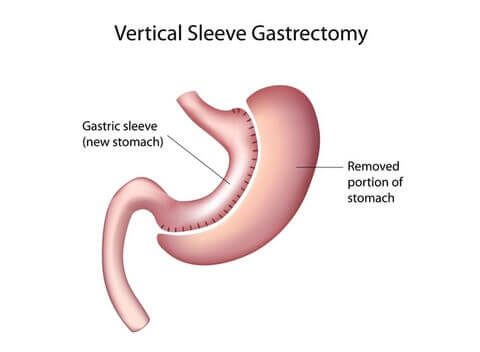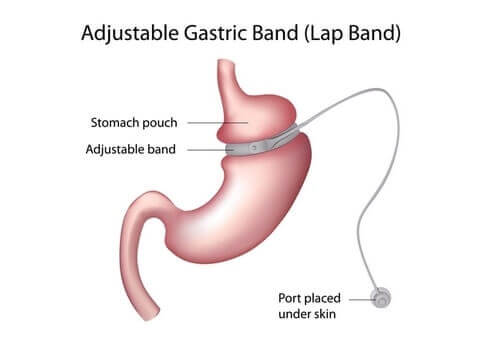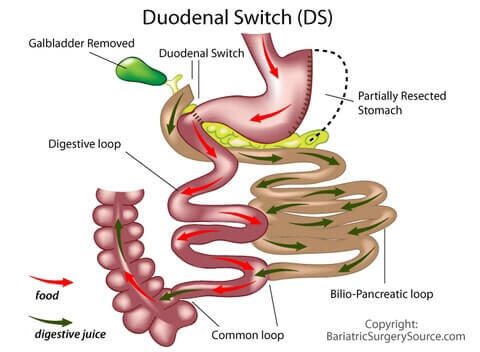Overweight patients seeking an effective gastric bypass alternative have 4 categories to choose from:
- Diet & exercise plans – often ineffective for people suffering from obesity
- Prescription weight loss drugs – result in 5 to 6 times less weight loss than gastric bypass
- Other surgical weight loss procedures – 5 procedures to choose from, some of which result in similar weight loss to gastric bypass
- Endoscopic (non-surgical) weight loss procedure – the gastric balloon results in about half the excess weight loss of gastric bypass and is only a temporary solution
Read the sections below for more details about each of these alternatives to gastric bypass.
TABLE OF CONTENTS
Click on any of the topics below to jump directly to that section
- Overview
- Diet & Exercise
- Prescription Weight Loss Drugs
- Surgical Procedures
- Endoscopic Procedures
- Patient Community & Expert Advice
- Find a Weight Loss Surgeon

SECTION SUMMARY:
- The average patient loses ~65% of excess weight within 1 year
- Surgery reduces your stomach size, as a result you feel full sooner while eating, eat less, and lose weight
- Rearranged intestines cause your body to absorb fewer minerals
- A side effect called "dumping syndrome" may deter patients from eating unhealthy foods
Weight Loss from Gastric Bypass
Gastric bypass patients usually lose a lot of weight very quickly. Within 3 months, the average patient will lose about one-third of their excess weight. By the one-year mark, almost two-thirds of the excess weight will be gone (about 25% of total body weight).
Many patients reach “peak” weight loss between one and two years, then gain a little back (more about Weight Regain in the “Downsides” section below). But long-term results are still impressive, with the average patient keeping about 60% of their excess weight off.
Why Gastric Bypass Works
- Reduced stomach size makes the patient feel full sooner after eating
- Rearranged intestines causes the body to absorb fewer minerals
- Dumping syndrome symptoms deter patients from eating unhealthy foods
See our Gastric Bypass Surgery Patient Guide for all of the details.
SECTION SUMMARY:
- Gastric bypass surgery results in much more weight loss and greater health benefits than diet an exercise if you're suffering from obesity
Diet and exercise is a gastric bypass alternative that you’ve probably heard or tried more times than you’d like to remember. But it’s a necessary first step that, if successful, is the lowest-risk way to lose weight.
If you are unable to lose weight and keep it off on your own, research has shown patients to be more open to losing weight under a doctor’s supervision. However, no combination of diet and exercise comes anywhere close to the weight loss results of gastric bypass:
- Going it alone – Self-guided program combining diet and exercise results in weight loss of about 3.6 lbs (1.64 kg). These sub-optimal results get even worse for removing the exercise component (1) (2).
- Medically supervised – Results in weight loss of about 13 lbs (5.9 kg) (3). Much better than going it alone, but still moderate relative to gastric bypass over the long-term.
- Gastric bypass – Results in weight loss of 50 – 100+ lbs (23 – 46 kg) (4).
A medically supervised weight loss program is still worth your while for three reasons:
- Some patients achieve much better weight loss than 13 lbs (5.9 kg)
- It does not carry the inherent risks and side effects of any major surgery
- If you want gastric bypass to be covered by insurance, your insurance company will require you to first complete a medically supervised program
Talk with your primary care physician or weight loss surgeon for information about starting a program.
For a deeper exploration of diet and exercise habits and other obesity contributors, see our Causes of Obesity page.

SECTION SUMMARY:
- There are two categories of prescription drugs for weight loss, both are ineffective when compared to gastric bypass surgery
If you have or are at risk of developing one of the many obesity-related health problems like diabetes, hypertension, or sleep apnea, and if you have a body mass index (BMI) of 27 or more, your doctor may prescribe one of several weight loss medications from two FDA-approved categories:
- Appetite suppressants (e.g., sibutramine, phentermine, diethylpropion, phendimetrazine, amfepramone, mazindol, etc) – make you feel full or lower your appetite
- Lipase inhibitors (orlistat) – reduce the body’s ability to absorb fat
Unfortunately, gastric bypass alternative pills result in a relatively small amount of weight loss compared to gastric bypass.
SECTION SUMMARY:
- Gastric sleeve
- LAP-BAND®
- Duodenal Switch
- AspireAssist
There are 5 gastric bypass surgery alternatives that are also performed using laparoscopic (minimally invasive) surgical techniques, including:
Gastric Sleeve

Why Gastric Sleeve Works
- Reduced stomach size makes the patient feel full sooner after eating
- Removed portion of the stomach means fewer hunger-causing hormones are secreted, causing patient to feel less hungry generally
How Gastric Sleeve Is Performed
Gastric sleeve surgery, also called the Vertical Sleeve Gastrectomy (VSG), is performed by removing a large portion of the stomach to create a long pouch that connects the esophagus to the small intestine. The pouch is stapled and the rest of the stomach is removed. Some surgeons take an additional step to reinforce the staple line, although whether that is effective is up for debate.
LAP-BAND®

Why LAP-BAND® Surgery Works
- A band wraps around and squeezes a narrow section in the upper-middle part of the stomach. This creates a smaller stomach “section” above the band which fills up quicker after eating, causing the patient to feel full sooner and eat less.
How LAP-BAND® Surgery Is Performed
The LAP-BAND®, also called the gastric band or laparoscopic adjustable gastric band, has been used in Europe since the 90’s but wasn’t approved by the FDA in the States until 2001.
The gastric band surgery procedure involves the sewing of a silicone and Silastic band around the top of the stomach. A balloon around the inner surface of the band (imagine the inside of a bicycle tire) is connected to a tube that leads to a half-dollar-sized port above the abdominal muscles but below the skin.
During follow up visits, your doctor will add or remove saline solution (salt water) to make it tighter or looser. The tighter it is, the less hungry you feel and vice-versa.
Duodenal Switch (DS)

Why the Duodenal Switch Works
- Reduced stomach size makes the patient feel full sooner after eating
- Removed portion of the stomach means fewer hunger-causing hormones are secreted, causing patient to feel less hungry generally
- Rearranged intestines causes the body to absorb fewer calories and minerals
How the Duodenal Switch Is Performed
More formally known as the Biliopancreatic Diversion with Duodenal Switch, the DS surgeon starts with a gastric sleeve to reduce the stomach size, then rearranges the intestines to reduce the amount of calories the body can absorb.
Here are the steps:
- A large portion of the stomach is removed to create a banana-shaped pouch connecting the esophagus to the top of the small intestine (just like a gastric sleeve).
- The top of the small intestine is cut, but the surgeon leaves part of the duodenum, the top part of the small intestine where most chemical digestion occurs, attached to the stomach.
- The surgeon then cuts the small intestine several feet down. The part that is still attached to the large intestine (colon) is connected to the duodenum.
- The loose part of the small intestine (the part that wasn’t just attached to the stomach) is then attached to the small intestine so the digestive juices it creates can mix with the food coming from the stomach.
AspireAssist Device
Why the AspireAssist Works
- A tube similar to a feeding tube is inserted into the stomach and attached to a port on the outside of the abdomen. A device is then attached to this port and used to drain a portion of the stomach’s contents before digestion.
The AspireAssist Tube is inserted as follows:
- An endoscope is inserted in your mouth and passed through to your stomach.
- A small incision is made in your abdomen and a wire is passed through the incision into your stomach.
- The endoscope grabs the wire, and then both the endoscope and wire are pulled back out of your mouth.
- The “A-Tube” is then attached to the wire, and both are pulled back into your stomach and out the incision in your abdomen until the tip of the tube exits your incision.
- After your incision has healed you will need to go back to the doctor for a very quick procedure to attach your Skin-Port.

SECTION SUMMARY:
- Gastric balloon results in far less weight loss and is only recommended for BMIs up to 40
- Click the link below to learn about the 4 types of gastric balloon
See our Gastric Balloon Patient Guide for more information.
SECTION SUMMARY:
- You can read about the experiences of other gastric sleeve patients
- You Can "Ask the Expert"
If you still have questions about a gastric bypass alternative, our experts are happy to answer them. We (and other patients) would also love to hear about your experiences.
Please use the form below to share your experience or ask a question.
Questions From Other Visitors*
Click below to see contributions from other visitors to this page.
Hello, I have chosen to do the gastric bypass surgery and while Googling around to find information on the bypass diet I found some forums talking about using the gastric…
SECTION SUMMARY:
- You can ask a local bariatric practice for a free insurance check or cost quote
- You can attend a free in-person seminar or an online webinar offered by a local weight loss surgeon
- You should schedule a phone or in-person consultation (both often free), if you are interested in learning more about weight loss surgery



